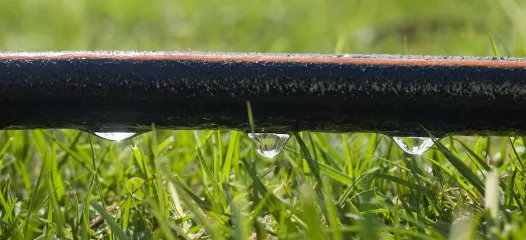Drip irrigation, choosing the right hose in 2024
Drip irrigation is the ideal solution for watering plants and trees in the garden. Drip irrigation offers a number of advantages in addition to using less water than traditional irrigation.
Advantages of drip irrigation :

Drip watering is less destructive for the plant because it is supplied with water at low pressure, slowly and initiated on demand.
Drip watering allows you to water the roots directly, so the water doesn’t touch the leaves of your plants directly and you avoid disease.
You target the root system of your plants, and minimise water loss through evaporation.
Drip irrigation is a progressive method of watering that allows you to give as much as the plant can absorb.
Your plant doesn’t receive a large amount of water, because the water is dispersed and delivered in the right quantities.
Drip watering is less destructive for the plant because it is supplied with water at low pressure, slowly and initiated on demand.
Drip watering allows you to water the roots directly, so the water doesn’t touch the leaves of your plants directly and you avoid disease.
You target the root system of your plants, and minimise water loss through evaporation.
Drip irrigation is a progressive method of watering that allows you to give as much as the plant can absorb.
Your plant doesn’t receive a large amount of water, because the water is dispersed and delivered in the right quantities.
Drip irrigation: Drip hose with integrated dripper

A drip hose with drippers is a quick and easy way to set up a drip irrigation system. It has the advantage of being simple to install, because the drippers are integrated directly into the polyethylene pipe, so there’s no risk of them catching when you position it.
Pipe with integrated dripper: How do I choose the right one?
THE SPACE BETWEEN DRIPPERS: In a drip irrigation system with internal drippers, you cannot freely install each of your drippers, so you will need to select a spacing between each dripper, usually 6 inch, 12 inch or 20 inch. You should select this spacing according to the type of plants you are targeting for drip irrigation. As we are looking to water as close as possible to the root system of each of your plants, make sure you select a spacing that corresponds to your growing plan.
THE PRESSURE: Pressure is a decisive factor in the installation of a drip system. You need to have enough pressure for each of your drippers (from the first to the last) to open and deliver enough water. If the pressure is high, we can install a pressure reducer at the start of your drip system to secure it. An adaptable pressure reducer is ideal.
Example: 100 drippers 2 litres/hour = 200 litres/hour
You can also choose a SELF-REGULATING drip crown with integrated drippers. Self-regulating drippers have a major advantage over conventional drippers: they include a membrane that regulates the flow of your dripper over a range of pressures. If you install this type of dripper, you won’t have to worry about pressure because you’ll have the right flow rate for each of your drippers if your pressure is between 0.5 bar and 4 bar. On average, a domestic tap delivers 2 to 3 bars of pressure.
DRIPPER TECHNOLOGY:The drippers are very small but they can include a lot of technology. Basic drippers are really quite simple – they just distribute water – but professional drippers offer other functions as well.
As we have already mentioned, they are self-regulating which means that if you do not have enough or too much pressure (between 0.5 and 4 bars) each of your drippers will still work and give the right amount of pressure. water (1 liter, 1.6 liters or 2 liters per hour). This also applies if you have sloping terrain. With a “classic” integrated dripper, your drippers at the bottom of the slope will deliver more water and you will therefore have irregular growth or even plants that will not grow. Self-regulating drippers solve this problem.

The enemy of the dripper is the root. You may not be aware of it, but the enemy of your dripper is the roots of your plants. Roots follow the water, so in drip irrigation you’re going to give water along a similar path and it’s therefore possible for a root to find its way to your dripper. But don’t worry, professional drippers incorporate an anti-root system. This is simply a membrane that closes when your drip irrigation is off, preventing roots from entering your irrigation system.
The anti-siphon mechanism is very important when you install drippers integrated into a crown. Ideally, when you unroll your wreath, you should make sure that each of your drippers has its water outlet on the side, but this is not easy to do. Quite often you’ll end up with a dripper whose outlet is in direct contact with the soil, which often means that in a vegetable garden or market garden, the dripper is in contact with the soil. When your drip irrigation cycle is stopped, this creates a depression in the dripper. Your dripper will then ‘suck in’ instead of ‘dumping out’ and you run the risk of creating a clog with soil getting into the dripper. This is exactly what the anti-siphon system prevents: it prevents your dripper from clogging.
Once you’ve considered all these factors, you’ll know which type of crown with which type of dripper to choose! But bear in mind that a crown with self-regulating drippers will be much simpler and more practical when it comes to setting up your drip system.

-
Drip irrigation, choosing the right hose in 2024
Drip irrigation, choosing the right hose in 2024 Drip irrigation is the ideal solution for watering plants and trees in the garden. Drip irrigation offers a number of advantages in addition to using less water than traditional irrigation. Advantages of…

Leave a Reply